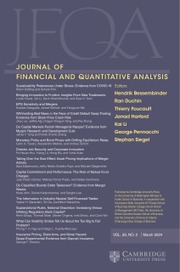No CrossRef data available.
Article contents
Order Exposure in High-Frequency Markets
Published online by Cambridge University Press: 12 September 2025
Abstract
We examine hidden orders usage by algorithmic traders (ATs) and nonATs. ATs extensively use hidden orders but of smaller size than nonATs, who are the primary contributors to hidden volume. ATs’ relative share of hidden volume decreases with volatility, adverse selection costs, and the relative tick-size. Proprietary ATs (HFTs), who differ from agency ATs (AATs) in their information sets and potential gains from trade, hide orders to reduce competition for liquidity provision, whereas AATs use hidden orders to conceal information in their more informed orders and manage picking-off risk. Finally, superior technology provides limited benefit for hidden order execution.
Information
- Type
- Research Article
- Information
- Creative Commons
- This is an Open Access article, distributed under the terms of the Creative Commons Attribution licence (http://creativecommons.org/licenses/by/4.0), which permits unrestricted re-use, distribution and reproduction, provided the original article is properly cited.
- Copyright
- © The Author(s), 2025. Published by Cambridge University Press on behalf of the Michael G. Foster School of Business, University of Washington
Footnotes
We thank an anonymous referee, David Abad, Haorui Bai, Ashok Banerjee, Michael Brolley, Sabrina Buti, Carole Comerton-Forde, Laurence Daures, Darrell Duffie, Thierry Foucault (the editor), Bart Frijns, Corey Garriott, Arie Gozluklu, Sudip Gupta, Bjorn Hagstromer, Frank Hatheway, Marta Khomyn, Sophie Moinas, Vitto Mollica, Lars Nordén, Venky Panchapagesan, Satchit Sagade, Ajay Shah, Andriy Shkilko, Kumar Venkataraman, Irena Vodenska, Gunther Wuyts, Pradeep Yadav, Mao Ye, and seminar participants at the Auckland Finance Meeting (Queenstown), Auckland University of Technology, Australasian Finance and Banking Conference (Sydney), Emerging Markets Finance Conference (IGIDR Mumbai), European Financial Management Association Meeting (Ponta Delgada), Finance Forum (Madrid), Financial Management Association European Meeting (Kristiansand), Financial Market Liquidity Conference (Budapest), Northern Finance Association Meeting (Charlevoix), NSE-NYU Conference, Plato Partnership Conference, EEA-ESEM Annual Meeting (Rotterdam), Saint Louis University, Stockholm Business School, Swiss Society for Financial Markets Research (Zurich), Universidad CEU Cardenal Herrera, University of Paris-Dauphine, and Wilfrid Laurier University for useful comments. This study is part of the NSE-NYU Stern School of Business Initiative for the Study of the Indian Capital Markets.

